HLWB 511: Reflective Report on Professional Portfolio Assessment 2
VerifiedAdded on 2022/10/08
|9
|2736
|65
Report
AI Summary
This reflective essay analyzes a student's learning experience from a leadership paper, focusing on the merits of strategy and project planning within a professional portfolio. The essay examines artifacts including a one-page strategy, an implementation plan, and a sub-plan, highlighting the mechanical aspects of a good strategy. However, it critiques the need for embedded support for culture change, organizational context understanding, and risk assessment. The essay explores various concepts such as safety culture, Lewin's change model, organizational cultures, probative blindness, project strategy, and risk mitigation in large-scale systems. The student integrates learnings from these topics and relates them to real-world issues, advocating for more flexible and dialogic approaches to strategy development and change management, especially emphasizing the importance of Lewin’s model's unfreeze phase and team-led project facilitation.
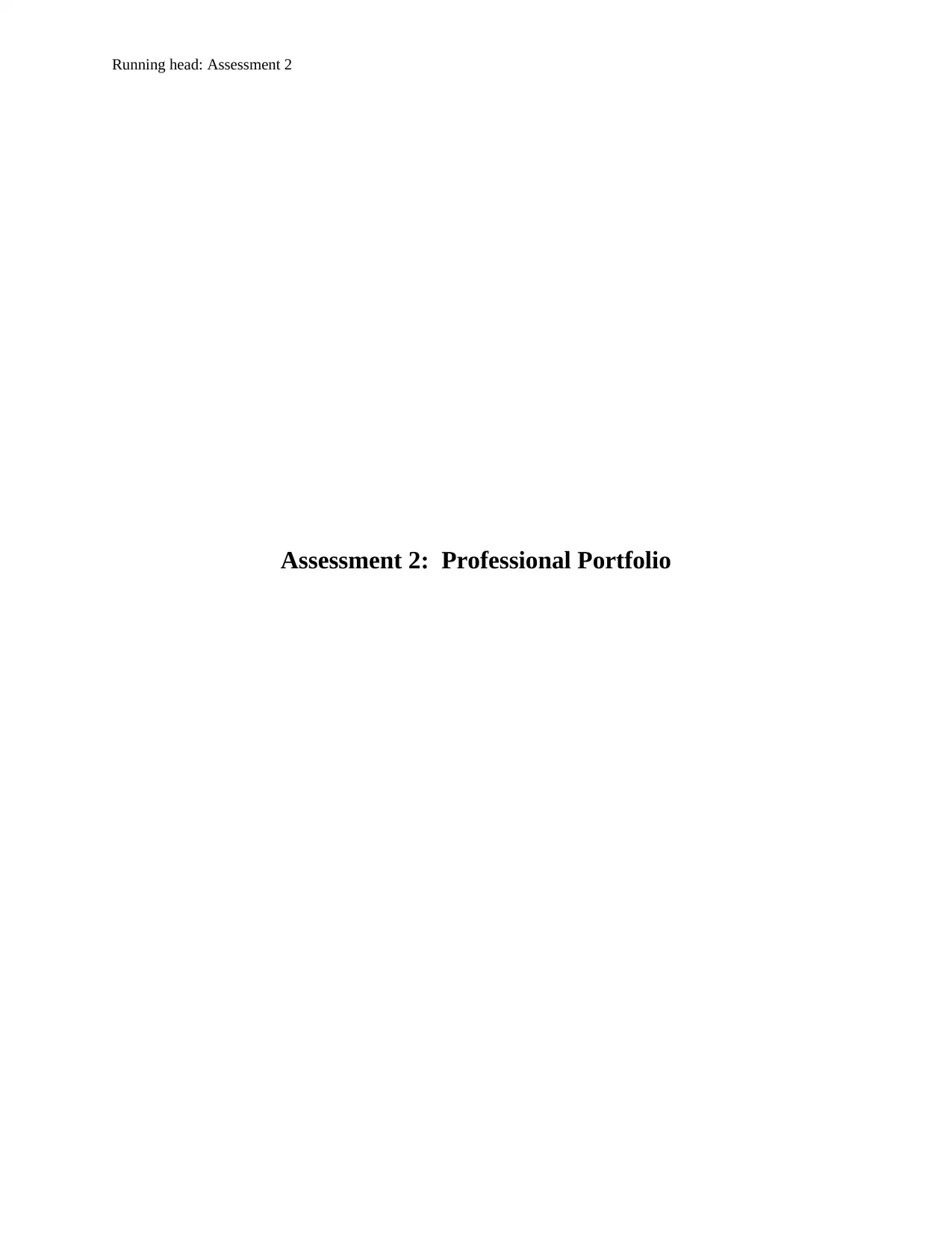
Running head: Assessment 2
Assessment 2: Professional Portfolio
Assessment 2: Professional Portfolio
Paraphrase This Document
Need a fresh take? Get an instant paraphrase of this document with our AI Paraphraser
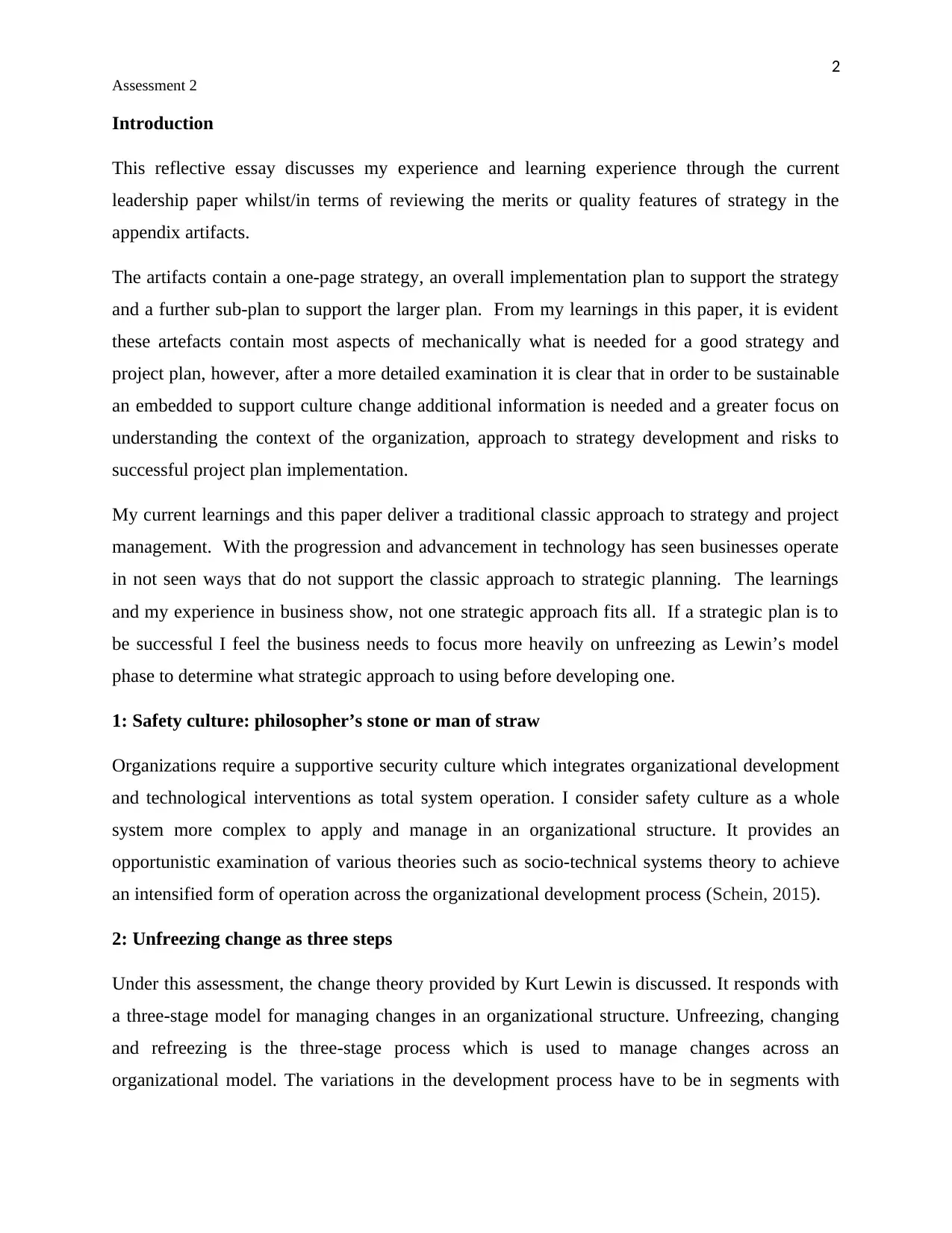
2
Assessment 2
Introduction
This reflective essay discusses my experience and learning experience through the current
leadership paper whilst/in terms of reviewing the merits or quality features of strategy in the
appendix artifacts.
The artifacts contain a one-page strategy, an overall implementation plan to support the strategy
and a further sub-plan to support the larger plan. From my learnings in this paper, it is evident
these artefacts contain most aspects of mechanically what is needed for a good strategy and
project plan, however, after a more detailed examination it is clear that in order to be sustainable
an embedded to support culture change additional information is needed and a greater focus on
understanding the context of the organization, approach to strategy development and risks to
successful project plan implementation.
My current learnings and this paper deliver a traditional classic approach to strategy and project
management. With the progression and advancement in technology has seen businesses operate
in not seen ways that do not support the classic approach to strategic planning. The learnings
and my experience in business show, not one strategic approach fits all. If a strategic plan is to
be successful I feel the business needs to focus more heavily on unfreezing as Lewin’s model
phase to determine what strategic approach to using before developing one.
1: Safety culture: philosopher’s stone or man of straw
Organizations require a supportive security culture which integrates organizational development
and technological interventions as total system operation. I consider safety culture as a whole
system more complex to apply and manage in an organizational structure. It provides an
opportunistic examination of various theories such as socio-technical systems theory to achieve
an intensified form of operation across the organizational development process (Schein, 2015).
2: Unfreezing change as three steps
Under this assessment, the change theory provided by Kurt Lewin is discussed. It responds with
a three-stage model for managing changes in an organizational structure. Unfreezing, changing
and refreezing is the three-stage process which is used to manage changes across an
organizational model. The variations in the development process have to be in segments with
Assessment 2
Introduction
This reflective essay discusses my experience and learning experience through the current
leadership paper whilst/in terms of reviewing the merits or quality features of strategy in the
appendix artifacts.
The artifacts contain a one-page strategy, an overall implementation plan to support the strategy
and a further sub-plan to support the larger plan. From my learnings in this paper, it is evident
these artefacts contain most aspects of mechanically what is needed for a good strategy and
project plan, however, after a more detailed examination it is clear that in order to be sustainable
an embedded to support culture change additional information is needed and a greater focus on
understanding the context of the organization, approach to strategy development and risks to
successful project plan implementation.
My current learnings and this paper deliver a traditional classic approach to strategy and project
management. With the progression and advancement in technology has seen businesses operate
in not seen ways that do not support the classic approach to strategic planning. The learnings
and my experience in business show, not one strategic approach fits all. If a strategic plan is to
be successful I feel the business needs to focus more heavily on unfreezing as Lewin’s model
phase to determine what strategic approach to using before developing one.
1: Safety culture: philosopher’s stone or man of straw
Organizations require a supportive security culture which integrates organizational development
and technological interventions as total system operation. I consider safety culture as a whole
system more complex to apply and manage in an organizational structure. It provides an
opportunistic examination of various theories such as socio-technical systems theory to achieve
an intensified form of operation across the organizational development process (Schein, 2015).
2: Unfreezing change as three steps
Under this assessment, the change theory provided by Kurt Lewin is discussed. It responds with
a three-stage model for managing changes in an organizational structure. Unfreezing, changing
and refreezing is the three-stage process which is used to manage changes across an
organizational model. The variations in the development process have to be in segments with
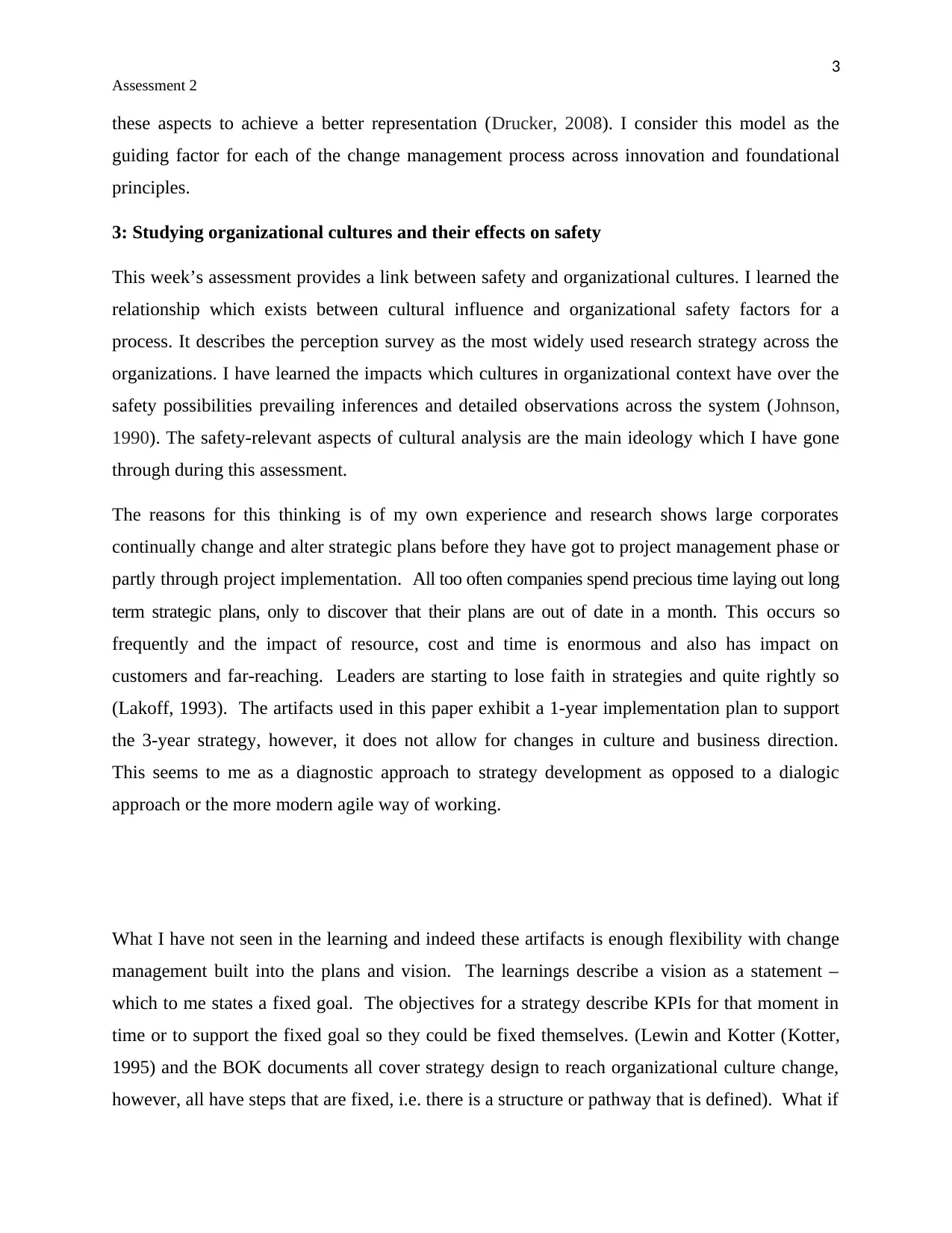
3
Assessment 2
these aspects to achieve a better representation (Drucker, 2008). I consider this model as the
guiding factor for each of the change management process across innovation and foundational
principles.
3: Studying organizational cultures and their effects on safety
This week’s assessment provides a link between safety and organizational cultures. I learned the
relationship which exists between cultural influence and organizational safety factors for a
process. It describes the perception survey as the most widely used research strategy across the
organizations. I have learned the impacts which cultures in organizational context have over the
safety possibilities prevailing inferences and detailed observations across the system (Johnson,
1990). The safety-relevant aspects of cultural analysis are the main ideology which I have gone
through during this assessment.
The reasons for this thinking is of my own experience and research shows large corporates
continually change and alter strategic plans before they have got to project management phase or
partly through project implementation. All too often companies spend precious time laying out long
term strategic plans, only to discover that their plans are out of date in a month. This occurs so
frequently and the impact of resource, cost and time is enormous and also has impact on
customers and far-reaching. Leaders are starting to lose faith in strategies and quite rightly so
(Lakoff, 1993). The artifacts used in this paper exhibit a 1-year implementation plan to support
the 3-year strategy, however, it does not allow for changes in culture and business direction.
This seems to me as a diagnostic approach to strategy development as opposed to a dialogic
approach or the more modern agile way of working.
What I have not seen in the learning and indeed these artifacts is enough flexibility with change
management built into the plans and vision. The learnings describe a vision as a statement –
which to me states a fixed goal. The objectives for a strategy describe KPIs for that moment in
time or to support the fixed goal so they could be fixed themselves. (Lewin and Kotter (Kotter,
1995) and the BOK documents all cover strategy design to reach organizational culture change,
however, all have steps that are fixed, i.e. there is a structure or pathway that is defined). What if
Assessment 2
these aspects to achieve a better representation (Drucker, 2008). I consider this model as the
guiding factor for each of the change management process across innovation and foundational
principles.
3: Studying organizational cultures and their effects on safety
This week’s assessment provides a link between safety and organizational cultures. I learned the
relationship which exists between cultural influence and organizational safety factors for a
process. It describes the perception survey as the most widely used research strategy across the
organizations. I have learned the impacts which cultures in organizational context have over the
safety possibilities prevailing inferences and detailed observations across the system (Johnson,
1990). The safety-relevant aspects of cultural analysis are the main ideology which I have gone
through during this assessment.
The reasons for this thinking is of my own experience and research shows large corporates
continually change and alter strategic plans before they have got to project management phase or
partly through project implementation. All too often companies spend precious time laying out long
term strategic plans, only to discover that their plans are out of date in a month. This occurs so
frequently and the impact of resource, cost and time is enormous and also has impact on
customers and far-reaching. Leaders are starting to lose faith in strategies and quite rightly so
(Lakoff, 1993). The artifacts used in this paper exhibit a 1-year implementation plan to support
the 3-year strategy, however, it does not allow for changes in culture and business direction.
This seems to me as a diagnostic approach to strategy development as opposed to a dialogic
approach or the more modern agile way of working.
What I have not seen in the learning and indeed these artifacts is enough flexibility with change
management built into the plans and vision. The learnings describe a vision as a statement –
which to me states a fixed goal. The objectives for a strategy describe KPIs for that moment in
time or to support the fixed goal so they could be fixed themselves. (Lewin and Kotter (Kotter,
1995) and the BOK documents all cover strategy design to reach organizational culture change,
however, all have steps that are fixed, i.e. there is a structure or pathway that is defined). What if
⊘ This is a preview!⊘
Do you want full access?
Subscribe today to unlock all pages.

Trusted by 1+ million students worldwide
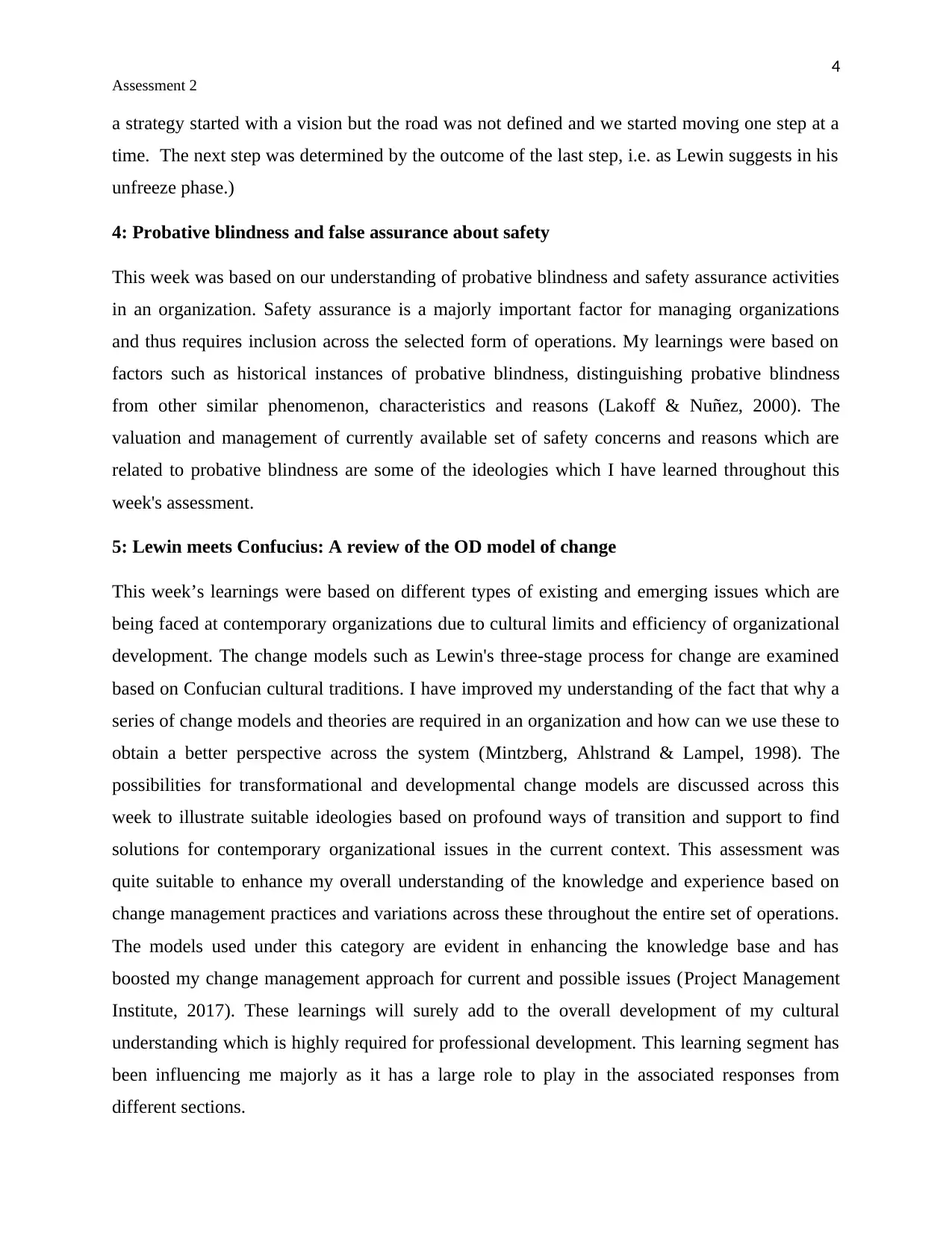
4
Assessment 2
a strategy started with a vision but the road was not defined and we started moving one step at a
time. The next step was determined by the outcome of the last step, i.e. as Lewin suggests in his
unfreeze phase.)
4: Probative blindness and false assurance about safety
This week was based on our understanding of probative blindness and safety assurance activities
in an organization. Safety assurance is a majorly important factor for managing organizations
and thus requires inclusion across the selected form of operations. My learnings were based on
factors such as historical instances of probative blindness, distinguishing probative blindness
from other similar phenomenon, characteristics and reasons (Lakoff & Nuñez, 2000). The
valuation and management of currently available set of safety concerns and reasons which are
related to probative blindness are some of the ideologies which I have learned throughout this
week's assessment.
5: Lewin meets Confucius: A review of the OD model of change
This week’s learnings were based on different types of existing and emerging issues which are
being faced at contemporary organizations due to cultural limits and efficiency of organizational
development. The change models such as Lewin's three-stage process for change are examined
based on Confucian cultural traditions. I have improved my understanding of the fact that why a
series of change models and theories are required in an organization and how can we use these to
obtain a better perspective across the system (Mintzberg, Ahlstrand & Lampel, 1998). The
possibilities for transformational and developmental change models are discussed across this
week to illustrate suitable ideologies based on profound ways of transition and support to find
solutions for contemporary organizational issues in the current context. This assessment was
quite suitable to enhance my overall understanding of the knowledge and experience based on
change management practices and variations across these throughout the entire set of operations.
The models used under this category are evident in enhancing the knowledge base and has
boosted my change management approach for current and possible issues (Project Management
Institute, 2017). These learnings will surely add to the overall development of my cultural
understanding which is highly required for professional development. This learning segment has
been influencing me majorly as it has a large role to play in the associated responses from
different sections.
Assessment 2
a strategy started with a vision but the road was not defined and we started moving one step at a
time. The next step was determined by the outcome of the last step, i.e. as Lewin suggests in his
unfreeze phase.)
4: Probative blindness and false assurance about safety
This week was based on our understanding of probative blindness and safety assurance activities
in an organization. Safety assurance is a majorly important factor for managing organizations
and thus requires inclusion across the selected form of operations. My learnings were based on
factors such as historical instances of probative blindness, distinguishing probative blindness
from other similar phenomenon, characteristics and reasons (Lakoff & Nuñez, 2000). The
valuation and management of currently available set of safety concerns and reasons which are
related to probative blindness are some of the ideologies which I have learned throughout this
week's assessment.
5: Lewin meets Confucius: A review of the OD model of change
This week’s learnings were based on different types of existing and emerging issues which are
being faced at contemporary organizations due to cultural limits and efficiency of organizational
development. The change models such as Lewin's three-stage process for change are examined
based on Confucian cultural traditions. I have improved my understanding of the fact that why a
series of change models and theories are required in an organization and how can we use these to
obtain a better perspective across the system (Mintzberg, Ahlstrand & Lampel, 1998). The
possibilities for transformational and developmental change models are discussed across this
week to illustrate suitable ideologies based on profound ways of transition and support to find
solutions for contemporary organizational issues in the current context. This assessment was
quite suitable to enhance my overall understanding of the knowledge and experience based on
change management practices and variations across these throughout the entire set of operations.
The models used under this category are evident in enhancing the knowledge base and has
boosted my change management approach for current and possible issues (Project Management
Institute, 2017). These learnings will surely add to the overall development of my cultural
understanding which is highly required for professional development. This learning segment has
been influencing me majorly as it has a large role to play in the associated responses from
different sections.
Paraphrase This Document
Need a fresh take? Get an instant paraphrase of this document with our AI Paraphraser
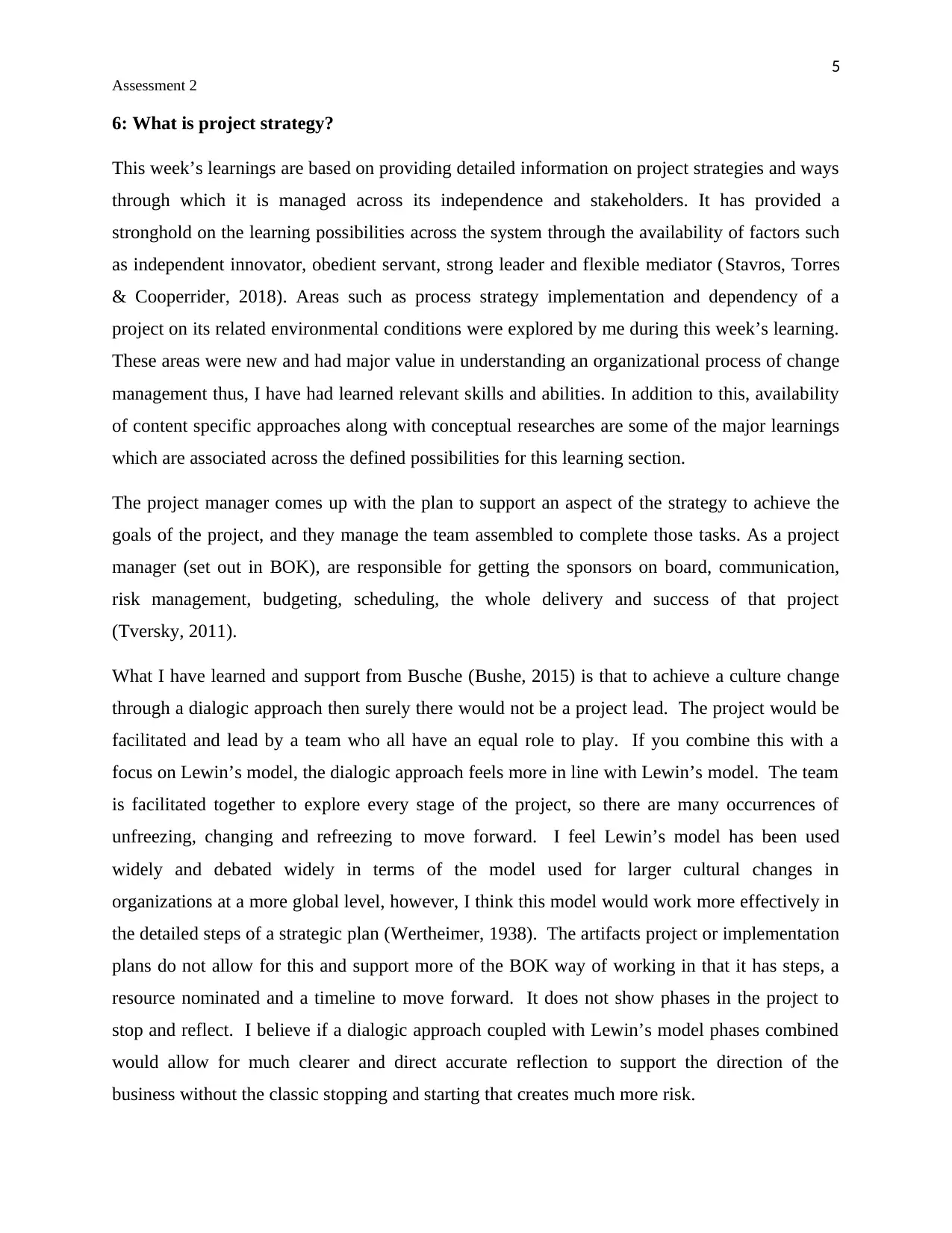
5
Assessment 2
6: What is project strategy?
This week’s learnings are based on providing detailed information on project strategies and ways
through which it is managed across its independence and stakeholders. It has provided a
stronghold on the learning possibilities across the system through the availability of factors such
as independent innovator, obedient servant, strong leader and flexible mediator (Stavros, Torres
& Cooperrider, 2018). Areas such as process strategy implementation and dependency of a
project on its related environmental conditions were explored by me during this week’s learning.
These areas were new and had major value in understanding an organizational process of change
management thus, I have had learned relevant skills and abilities. In addition to this, availability
of content specific approaches along with conceptual researches are some of the major learnings
which are associated across the defined possibilities for this learning section.
The project manager comes up with the plan to support an aspect of the strategy to achieve the
goals of the project, and they manage the team assembled to complete those tasks. As a project
manager (set out in BOK), are responsible for getting the sponsors on board, communication,
risk management, budgeting, scheduling, the whole delivery and success of that project
(Tversky, 2011).
What I have learned and support from Busche (Bushe, 2015) is that to achieve a culture change
through a dialogic approach then surely there would not be a project lead. The project would be
facilitated and lead by a team who all have an equal role to play. If you combine this with a
focus on Lewin’s model, the dialogic approach feels more in line with Lewin’s model. The team
is facilitated together to explore every stage of the project, so there are many occurrences of
unfreezing, changing and refreezing to move forward. I feel Lewin’s model has been used
widely and debated widely in terms of the model used for larger cultural changes in
organizations at a more global level, however, I think this model would work more effectively in
the detailed steps of a strategic plan (Wertheimer, 1938). The artifacts project or implementation
plans do not allow for this and support more of the BOK way of working in that it has steps, a
resource nominated and a timeline to move forward. It does not show phases in the project to
stop and reflect. I believe if a dialogic approach coupled with Lewin’s model phases combined
would allow for much clearer and direct accurate reflection to support the direction of the
business without the classic stopping and starting that creates much more risk.
Assessment 2
6: What is project strategy?
This week’s learnings are based on providing detailed information on project strategies and ways
through which it is managed across its independence and stakeholders. It has provided a
stronghold on the learning possibilities across the system through the availability of factors such
as independent innovator, obedient servant, strong leader and flexible mediator (Stavros, Torres
& Cooperrider, 2018). Areas such as process strategy implementation and dependency of a
project on its related environmental conditions were explored by me during this week’s learning.
These areas were new and had major value in understanding an organizational process of change
management thus, I have had learned relevant skills and abilities. In addition to this, availability
of content specific approaches along with conceptual researches are some of the major learnings
which are associated across the defined possibilities for this learning section.
The project manager comes up with the plan to support an aspect of the strategy to achieve the
goals of the project, and they manage the team assembled to complete those tasks. As a project
manager (set out in BOK), are responsible for getting the sponsors on board, communication,
risk management, budgeting, scheduling, the whole delivery and success of that project
(Tversky, 2011).
What I have learned and support from Busche (Bushe, 2015) is that to achieve a culture change
through a dialogic approach then surely there would not be a project lead. The project would be
facilitated and lead by a team who all have an equal role to play. If you combine this with a
focus on Lewin’s model, the dialogic approach feels more in line with Lewin’s model. The team
is facilitated together to explore every stage of the project, so there are many occurrences of
unfreezing, changing and refreezing to move forward. I feel Lewin’s model has been used
widely and debated widely in terms of the model used for larger cultural changes in
organizations at a more global level, however, I think this model would work more effectively in
the detailed steps of a strategic plan (Wertheimer, 1938). The artifacts project or implementation
plans do not allow for this and support more of the BOK way of working in that it has steps, a
resource nominated and a timeline to move forward. It does not show phases in the project to
stop and reflect. I believe if a dialogic approach coupled with Lewin’s model phases combined
would allow for much clearer and direct accurate reflection to support the direction of the
business without the classic stopping and starting that creates much more risk.
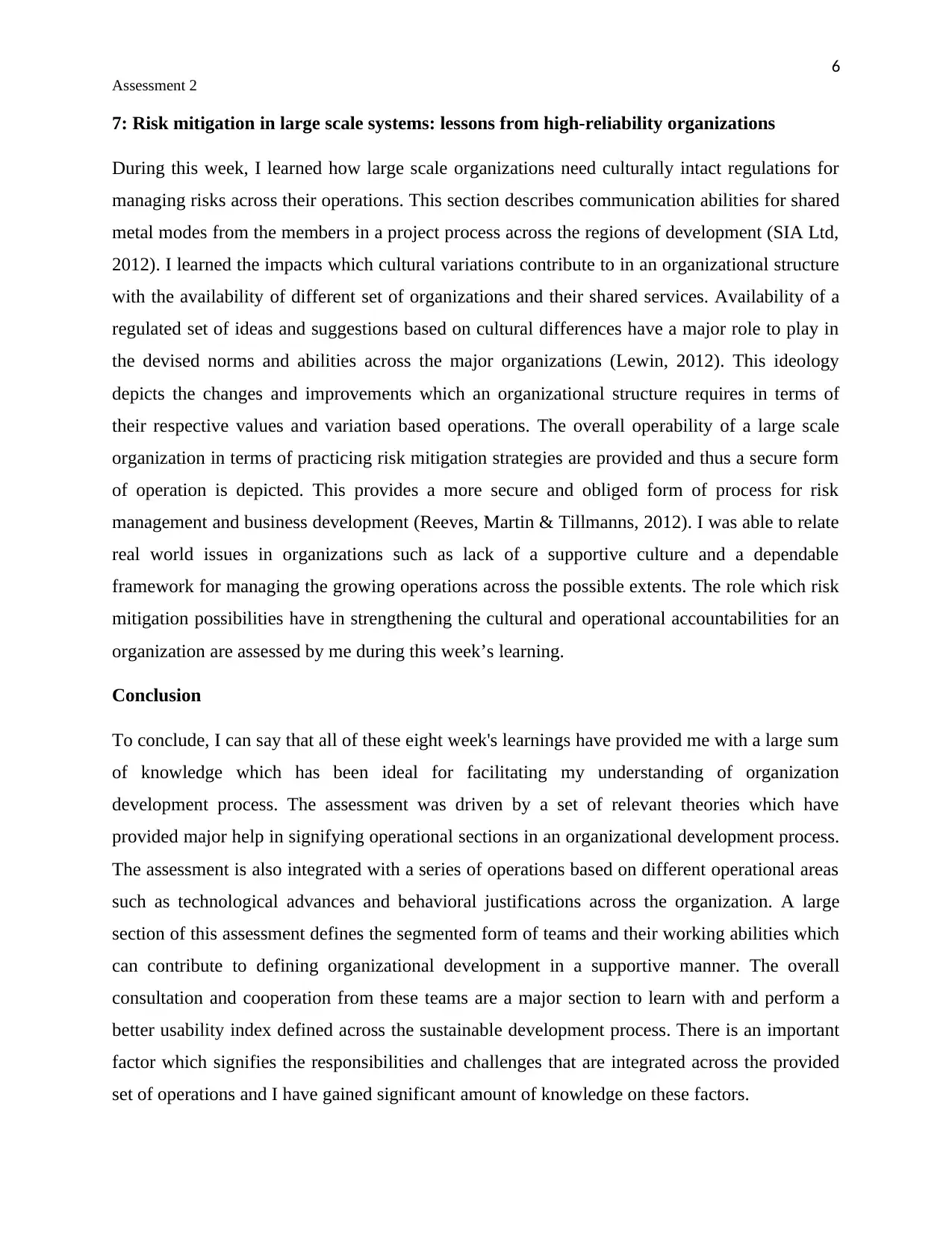
6
Assessment 2
7: Risk mitigation in large scale systems: lessons from high-reliability organizations
During this week, I learned how large scale organizations need culturally intact regulations for
managing risks across their operations. This section describes communication abilities for shared
metal modes from the members in a project process across the regions of development (SIA Ltd,
2012). I learned the impacts which cultural variations contribute to in an organizational structure
with the availability of different set of organizations and their shared services. Availability of a
regulated set of ideas and suggestions based on cultural differences have a major role to play in
the devised norms and abilities across the major organizations (Lewin, 2012). This ideology
depicts the changes and improvements which an organizational structure requires in terms of
their respective values and variation based operations. The overall operability of a large scale
organization in terms of practicing risk mitigation strategies are provided and thus a secure form
of operation is depicted. This provides a more secure and obliged form of process for risk
management and business development (Reeves, Martin & Tillmanns, 2012). I was able to relate
real world issues in organizations such as lack of a supportive culture and a dependable
framework for managing the growing operations across the possible extents. The role which risk
mitigation possibilities have in strengthening the cultural and operational accountabilities for an
organization are assessed by me during this week’s learning.
Conclusion
To conclude, I can say that all of these eight week's learnings have provided me with a large sum
of knowledge which has been ideal for facilitating my understanding of organization
development process. The assessment was driven by a set of relevant theories which have
provided major help in signifying operational sections in an organizational development process.
The assessment is also integrated with a series of operations based on different operational areas
such as technological advances and behavioral justifications across the organization. A large
section of this assessment defines the segmented form of teams and their working abilities which
can contribute to defining organizational development in a supportive manner. The overall
consultation and cooperation from these teams are a major section to learn with and perform a
better usability index defined across the sustainable development process. There is an important
factor which signifies the responsibilities and challenges that are integrated across the provided
set of operations and I have gained significant amount of knowledge on these factors.
Assessment 2
7: Risk mitigation in large scale systems: lessons from high-reliability organizations
During this week, I learned how large scale organizations need culturally intact regulations for
managing risks across their operations. This section describes communication abilities for shared
metal modes from the members in a project process across the regions of development (SIA Ltd,
2012). I learned the impacts which cultural variations contribute to in an organizational structure
with the availability of different set of organizations and their shared services. Availability of a
regulated set of ideas and suggestions based on cultural differences have a major role to play in
the devised norms and abilities across the major organizations (Lewin, 2012). This ideology
depicts the changes and improvements which an organizational structure requires in terms of
their respective values and variation based operations. The overall operability of a large scale
organization in terms of practicing risk mitigation strategies are provided and thus a secure form
of operation is depicted. This provides a more secure and obliged form of process for risk
management and business development (Reeves, Martin & Tillmanns, 2012). I was able to relate
real world issues in organizations such as lack of a supportive culture and a dependable
framework for managing the growing operations across the possible extents. The role which risk
mitigation possibilities have in strengthening the cultural and operational accountabilities for an
organization are assessed by me during this week’s learning.
Conclusion
To conclude, I can say that all of these eight week's learnings have provided me with a large sum
of knowledge which has been ideal for facilitating my understanding of organization
development process. The assessment was driven by a set of relevant theories which have
provided major help in signifying operational sections in an organizational development process.
The assessment is also integrated with a series of operations based on different operational areas
such as technological advances and behavioral justifications across the organization. A large
section of this assessment defines the segmented form of teams and their working abilities which
can contribute to defining organizational development in a supportive manner. The overall
consultation and cooperation from these teams are a major section to learn with and perform a
better usability index defined across the sustainable development process. There is an important
factor which signifies the responsibilities and challenges that are integrated across the provided
set of operations and I have gained significant amount of knowledge on these factors.
⊘ This is a preview!⊘
Do you want full access?
Subscribe today to unlock all pages.

Trusted by 1+ million students worldwide
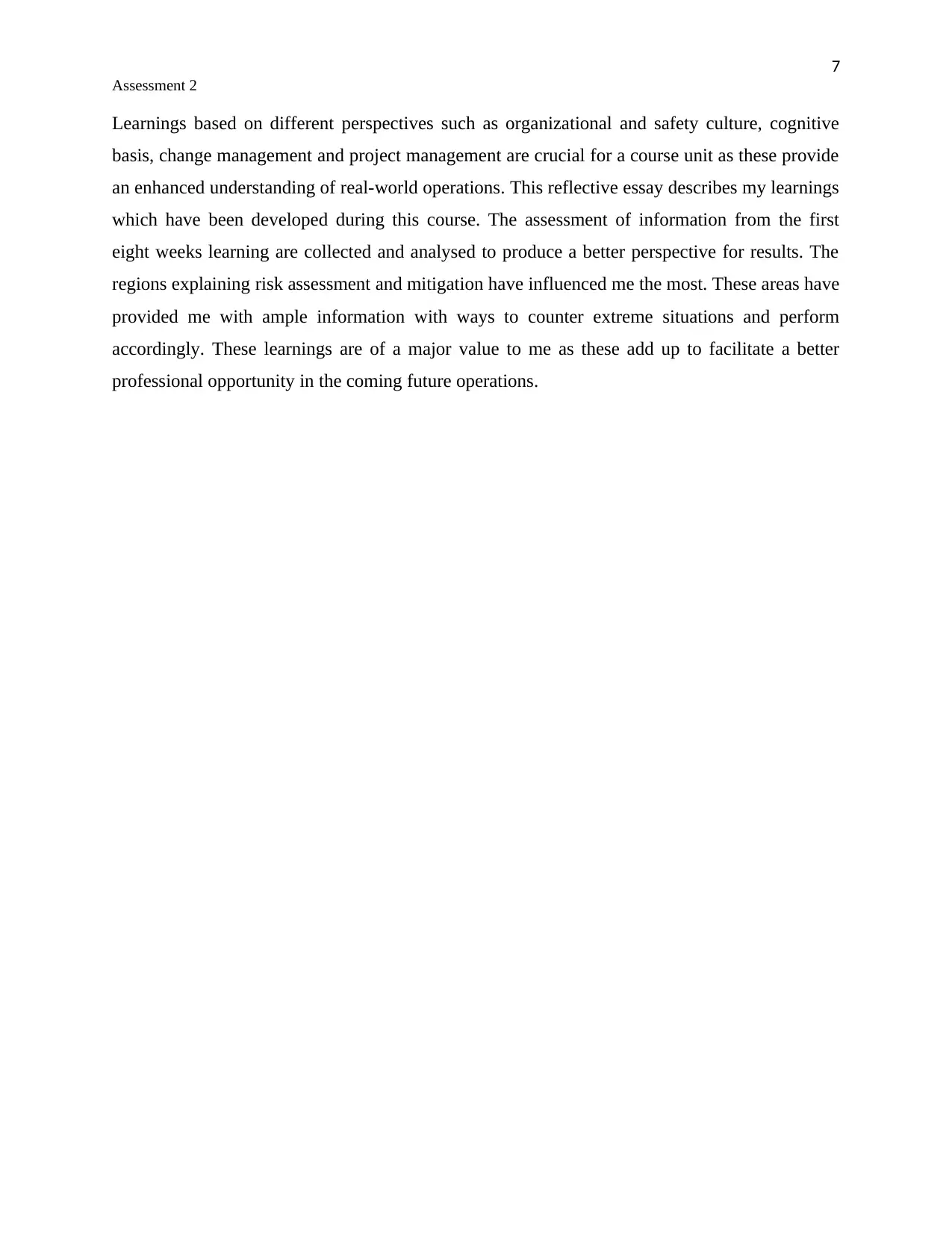
7
Assessment 2
Learnings based on different perspectives such as organizational and safety culture, cognitive
basis, change management and project management are crucial for a course unit as these provide
an enhanced understanding of real-world operations. This reflective essay describes my learnings
which have been developed during this course. The assessment of information from the first
eight weeks learning are collected and analysed to produce a better perspective for results. The
regions explaining risk assessment and mitigation have influenced me the most. These areas have
provided me with ample information with ways to counter extreme situations and perform
accordingly. These learnings are of a major value to me as these add up to facilitate a better
professional opportunity in the coming future operations.
Assessment 2
Learnings based on different perspectives such as organizational and safety culture, cognitive
basis, change management and project management are crucial for a course unit as these provide
an enhanced understanding of real-world operations. This reflective essay describes my learnings
which have been developed during this course. The assessment of information from the first
eight weeks learning are collected and analysed to produce a better perspective for results. The
regions explaining risk assessment and mitigation have influenced me the most. These areas have
provided me with ample information with ways to counter extreme situations and perform
accordingly. These learnings are of a major value to me as these add up to facilitate a better
professional opportunity in the coming future operations.
Paraphrase This Document
Need a fresh take? Get an instant paraphrase of this document with our AI Paraphraser
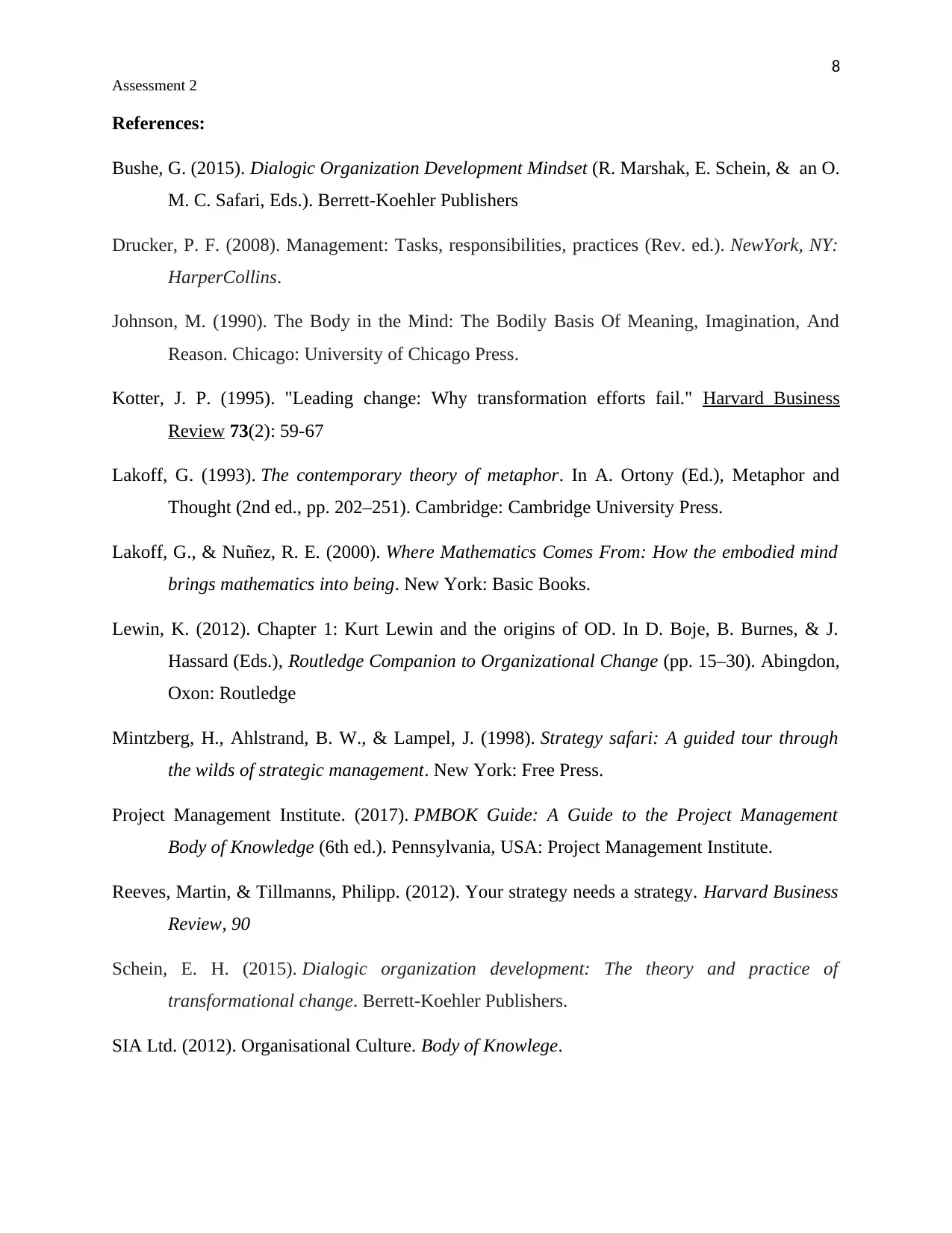
8
Assessment 2
References:
Bushe, G. (2015). Dialogic Organization Development Mindset (R. Marshak, E. Schein, & an O.
M. C. Safari, Eds.). Berrett-Koehler Publishers
Drucker, P. F. (2008). Management: Tasks, responsibilities, practices (Rev. ed.). NewYork, NY:
HarperCollins.
Johnson, M. (1990). The Body in the Mind: The Bodily Basis Of Meaning, Imagination, And
Reason. Chicago: University of Chicago Press.
Kotter, J. P. (1995). "Leading change: Why transformation efforts fail." Harvard Business
Review 73(2): 59-67
Lakoff, G. (1993). The contemporary theory of metaphor. In A. Ortony (Ed.), Metaphor and
Thought (2nd ed., pp. 202–251). Cambridge: Cambridge University Press.
Lakoff, G., & Nuñez, R. E. (2000). Where Mathematics Comes From: How the embodied mind
brings mathematics into being. New York: Basic Books.
Lewin, K. (2012). Chapter 1: Kurt Lewin and the origins of OD. In D. Boje, B. Burnes, & J.
Hassard (Eds.), Routledge Companion to Organizational Change (pp. 15–30). Abingdon,
Oxon: Routledge
Mintzberg, H., Ahlstrand, B. W., & Lampel, J. (1998). Strategy safari: A guided tour through
the wilds of strategic management. New York: Free Press.
Project Management Institute. (2017). PMBOK Guide: A Guide to the Project Management
Body of Knowledge (6th ed.). Pennsylvania, USA: Project Management Institute.
Reeves, Martin, & Tillmanns, Philipp. (2012). Your strategy needs a strategy. Harvard Business
Review, 90
Schein, E. H. (2015). Dialogic organization development: The theory and practice of
transformational change. Berrett-Koehler Publishers.
SIA Ltd. (2012). Organisational Culture. Body of Knowlege.
Assessment 2
References:
Bushe, G. (2015). Dialogic Organization Development Mindset (R. Marshak, E. Schein, & an O.
M. C. Safari, Eds.). Berrett-Koehler Publishers
Drucker, P. F. (2008). Management: Tasks, responsibilities, practices (Rev. ed.). NewYork, NY:
HarperCollins.
Johnson, M. (1990). The Body in the Mind: The Bodily Basis Of Meaning, Imagination, And
Reason. Chicago: University of Chicago Press.
Kotter, J. P. (1995). "Leading change: Why transformation efforts fail." Harvard Business
Review 73(2): 59-67
Lakoff, G. (1993). The contemporary theory of metaphor. In A. Ortony (Ed.), Metaphor and
Thought (2nd ed., pp. 202–251). Cambridge: Cambridge University Press.
Lakoff, G., & Nuñez, R. E. (2000). Where Mathematics Comes From: How the embodied mind
brings mathematics into being. New York: Basic Books.
Lewin, K. (2012). Chapter 1: Kurt Lewin and the origins of OD. In D. Boje, B. Burnes, & J.
Hassard (Eds.), Routledge Companion to Organizational Change (pp. 15–30). Abingdon,
Oxon: Routledge
Mintzberg, H., Ahlstrand, B. W., & Lampel, J. (1998). Strategy safari: A guided tour through
the wilds of strategic management. New York: Free Press.
Project Management Institute. (2017). PMBOK Guide: A Guide to the Project Management
Body of Knowledge (6th ed.). Pennsylvania, USA: Project Management Institute.
Reeves, Martin, & Tillmanns, Philipp. (2012). Your strategy needs a strategy. Harvard Business
Review, 90
Schein, E. H. (2015). Dialogic organization development: The theory and practice of
transformational change. Berrett-Koehler Publishers.
SIA Ltd. (2012). Organisational Culture. Body of Knowlege.
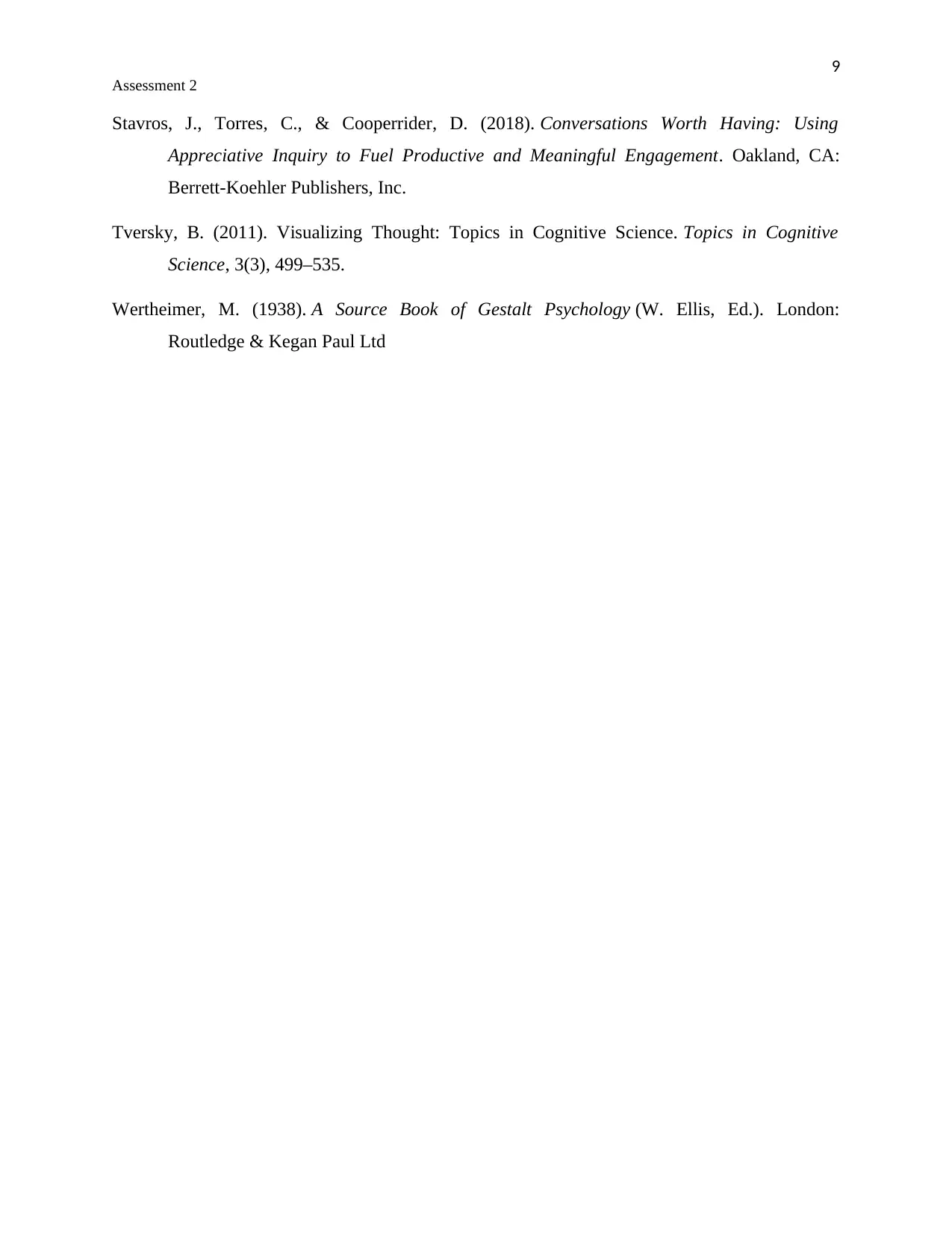
9
Assessment 2
Stavros, J., Torres, C., & Cooperrider, D. (2018). Conversations Worth Having: Using
Appreciative Inquiry to Fuel Productive and Meaningful Engagement. Oakland, CA:
Berrett-Koehler Publishers, Inc.
Tversky, B. (2011). Visualizing Thought: Topics in Cognitive Science. Topics in Cognitive
Science, 3(3), 499–535.
Wertheimer, M. (1938). A Source Book of Gestalt Psychology (W. Ellis, Ed.). London:
Routledge & Kegan Paul Ltd
Assessment 2
Stavros, J., Torres, C., & Cooperrider, D. (2018). Conversations Worth Having: Using
Appreciative Inquiry to Fuel Productive and Meaningful Engagement. Oakland, CA:
Berrett-Koehler Publishers, Inc.
Tversky, B. (2011). Visualizing Thought: Topics in Cognitive Science. Topics in Cognitive
Science, 3(3), 499–535.
Wertheimer, M. (1938). A Source Book of Gestalt Psychology (W. Ellis, Ed.). London:
Routledge & Kegan Paul Ltd
⊘ This is a preview!⊘
Do you want full access?
Subscribe today to unlock all pages.

Trusted by 1+ million students worldwide
1 out of 9
Related Documents
Your All-in-One AI-Powered Toolkit for Academic Success.
+13062052269
info@desklib.com
Available 24*7 on WhatsApp / Email
![[object Object]](/_next/static/media/star-bottom.7253800d.svg)
Unlock your academic potential
Copyright © 2020–2025 A2Z Services. All Rights Reserved. Developed and managed by ZUCOL.





